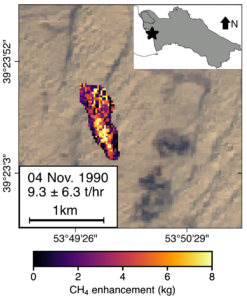Prof. Alex Turner’s research on Methane Emissions in Turkmenistan featured on UW News

AI analysis of historical satellite images show USSR collapse in 1990s increased methane emissions, despite lower oil and gas production. But new University of Washington research uses early satellite records to dispute that assumption. The study, published March 12 in the Proceedings of the National Academy of Sciences, finds that methane emissions in Turkmenistan, a former Soviet republic and major oil producer, actually increased in the years following the dissolution of the Soviet Union.
“Methane has these enigmatic trends that we don’t really understand,” said senior author Alex Turner, a UW assistant professor of atmospheric sciences. “One that has always been fascinating is this slowdown in 1992. We find that the collapse of the Soviet Union seems to result, surprisingly, in an increase in methane emissions.”
Carbon dioxide is more important than methane for long-term global warming, but methane plays an important role in the shorter term. One molecule of methane has more heat-trapping power than CO2, and its half-life in the atmosphere is just a decade, meaning its levels can fluctuate.
In recent years, the rise of methane accelerated during COVID-19 lockdowns. Turner’s previous research showed that less driving and thus fewer vehicle emissions containing reactive nitrogen (an air pollutant) likely played a role, because pollution was no longer able to combine with methane molecules to remove them from the atmosphere.
The new study explores a longer-term conundrum: an abrupt slowing in the rise of methane concentrations in the atmosphere in 1992.
Read more about the study on UW News.